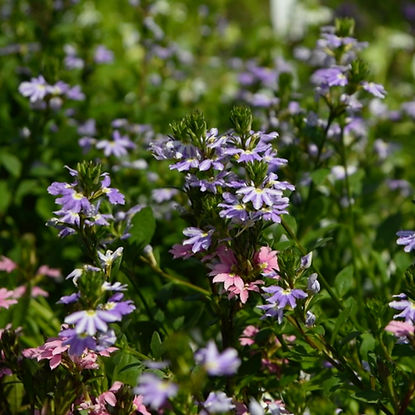Fan Flower
Scaevola

Scaevola: The Indestructible Fan Flower for Summer Sun
Scaevola, commonly known as the Fan Flower, is a tough and beautiful warm-season annual prized for its remarkable heat tolerance and unique, eye-catching blooms. Its most distinctive feature is its flowers, which look like tiny, one-sided fans with five petals arranged in a perfect semicircle. These fan-shaped blossoms, typically in shades of brilliant blue, lavender, purple, white, or soft pink, cover the plant's trailing stems from spring until the first frost. With its vigorous, cascading growth habit, Scaevola is a true superstar for spilling over the edges of hanging baskets, window boxes, and retaining walls. Scaevola is exceptionally easy to grow, making it a perfect choice for both beginner gardeners and experts looking for a dependable, "plant-it-and-forget-it" option for sunny locations. It is a true problem-solver for those hot, dry areas where other flowers struggle.
Why is Scaevola a Summer Superstar?
The Fan Flower has surged in popularity because it doesn't just survive the summer heat; it thrives in it. It is one of the most reliable and hardworking annuals you can plant.
Exceptional Heat and Drought Tolerance: This is its number one trait. Scaevola flourishes in the full, blazing sun and high heat of July and August, looking fresh and vibrant when other plants wilt.
Self-Cleaning: The plant requires no deadheading. Spent blooms drop off on their own, making it incredibly low-maintenance.
Vigorous Growth: It quickly fills in containers and garden beds with a cascade of color, providing a lush, full look with very little effort.
Pest and Disease Resistant: Scaevola is rarely bothered by insects or diseases, making it a healthy and reliable performer.
Unique Beauty: The unusual fan-shaped flowers add a unique texture and form to container combinations and garden designs.
When to Plant:
Scaevola is a heat-loving plant and should only be planted after all danger of frost has passed and the soil has thoroughly warmed up. The ideal time to plant it NJ (Zone 6b/7a) is from late May through June and throughout the entire season up until frost. During summer it will take off immediately in the summer heat and perform beautifully all the way until the fall frost, making it an excellent choice for filling in gaps or replacing early-season annuals that have faded.
Growing Instructions:
Sunlight: Give it full, direct sun for at least 6 to 8 hours a day. It needs sun to produce a profusion of flowers.
Soil: Excellent drainage is non-negotiable. Scaevola hates "wet feet" and is susceptible to root rot in soggy soil. It is ideal for sandy or gritty soils. If planting in containers, use a standard, high-quality potting mix.
Watering: Water well when first planted to help it get established. Afterward, it is very drought-tolerant. Allow the top inch or two of soil to dry out completely before watering again.
Care and Maintenance: No deadheading is needed. If the trailing stems become too long later in the season, you can give them a light trim to encourage bushier growth, but this is rarely necessary.
A "Left-Handed" Flower with a Legendary Story
The Fan Flower is native to the coastal dunes and dry inland areas of Australia and Polynesia, which explains its inherent toughness and love for sun and sand. The botanical name, Scaevola, comes from the Latin word scaevus, which means "left-handed." This is a direct and fitting reference to the unique, one-sided shape of the flower.
While the garden varieties are mostly from Australia, the plant has a beautiful and romantic story in Hawaiian folklore. The native Hawaiian Fan Flower, known as Naupaka, is part of a legend about two lovers, Princess Naupaka and a commoner named Kaui, who were forbidden from being together. Heartbroken, the princess tore a flower in half, giving one half to Kaui before they separated forever. The Naupaka plants in the mountains (where the princess went) and by the sea (where Kaui lived) have only bloomed in half-flowers ever since, waiting to be made whole again. This poignant legend perfectly captures the unique form of this beautiful flower.
Spiller
